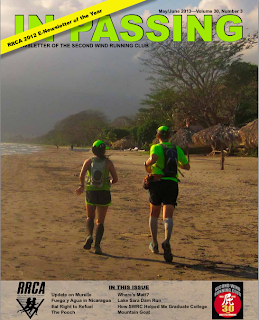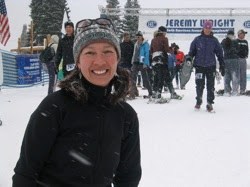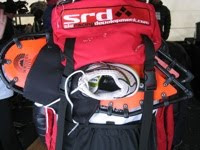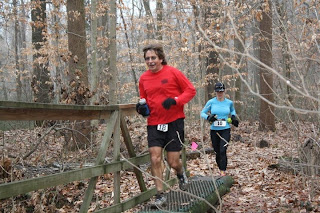In February, five Second Winders competed in a series of endurance events, called Fuego y Agua, on the volcanic island of Ometepe in LakeNicaragua. There were many incredible bloggers who produced better reports than anything I could ever write, with photos and video. Some links to those are at the end of this report. Here, I’ll highlight a few things that made my 50K race special.
One of the great things about Second Wind is how those who move away always reappear. Every new race becomes a chance to renew an old friendship. Second Winders Rob and Melissa Raguet-Schoefield moved to St. Louis several years ago after Melissa completed her Ph.D. at Illinois. Melissa’s fieldwork on howler monkeys led her and Rob to the Nicaraguan island of Ometepe, where these monkeys are found. During their two years there, Rob ran the 2012 Fuego y Agua as his first 50K. Eager to return, he put an online shout-out to the Buffalo, a group of Second Wind trail runners. Heeding the call were Don Frichtl, Jen Burton, me, and Brian Kuhn, another former Second Winder who now lives in Austin. We couldn’t resist running up a tropical volcano during February. Jen, in particular, was destined to do this race. Just weeks before sign-up, she had received a gift basket filled with food, including a mystery box mix of Gallo Pinto, a pilaf of beans and rice. We were to learn that it was Nicaragua’s national dish, to be had morning, noon, and night with every Nica-style meal.
 |
| Volcans Concepcion on the left, and Maderas n the right, viewed from the ferry. |
In its fourth year, 2013’s Fuego y Agua featured 25K, 50K, and 100K distances, and for the first time a 70K survival run. At the heart of the races are the two volcanoes that dominate Ometepe. Volcan Concepcion is a live one, hence Fuego (fire). Volcan Maderas is dormant, and a small lake sits in its caldera, hence Agua (water). The 25K took place on Concepcion, the larger of the two, and the 50K went up and down Maderas. The 100K and survival runners had to do some of both.
Fuego y Agua attracts amateur and elite athletes worldwide, and as word gets out, the race is becoming more popular. Race director Josue Stevens is also the director of the Copper Canyon race that was featured in Chris McDougal’s book Born to Run and was recently renamed after its founder, Caballo Blanco. Eric Orton, the coach that helped McDougal run again, was running the 50K.
The camaraderie at Fuego y Agua was at least as memorable as the race itself. More than 220 runners
swamped the small town of Moyogalpa, race headquarters. By the end, most of us recognized each other from sharing sidewalks, tables in restaurants, seats on the ferry boat, and tough times on the trail.
Fuego y Agua was the first to unite both the ultrarunning and obstacle racing communities. Each thought the other was nuts. I am here to tell you that it’s a slam-dunk. The obstacle racers take the crazy
cake. Nutshell: The invitation-only survival race attracted the world’s top racers of this genre, including champion Junyong Pak. Of the 37 who started, only two finished. He was one of them. And yes, live chickens were involved.
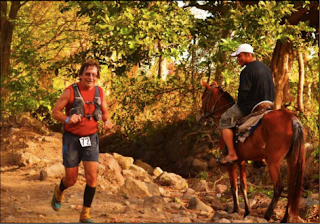 |
| Don shares the trail with a local. |
Another great feature of Fuego y Agua was its tight connection to the island and its people. Everyone could feel the goodwill between the runners and the islanders. Nicaragua is the second poorest country in the western hemisphere, after Haiti, and the race organizers wanted this race not only to give back to the community, but to involve its members. Islanders and runners participated in the island cleanup held prior to race day, and in the kid’s race held the day after. Boys and girls from all over the island ran a 5K on the streets of Moyogalpa, and received race shirts and a pair of running shoes at the finish line. The shoes were donated by companies and by the racers themselves. I love the idea that a pair of my shoes is being worn, and perhaps run in, on Ometepe.
Jen and I ran the 50K. It’s hard to call it a run. It was more like a 30K run through an extraordinary and unfamiliar culture followed by 20K of one-two-
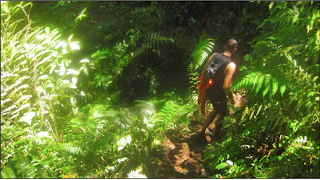 |
| The vegetation changed dramatically as we ascended Volcan Maderas. |
Sunrise revealed the utter beauty of the island. As we ran on cobblestone roads through tiny villages, past extremely humble dwellings, we exchanged ¡Holas! with the people who lived there, shared the trail with horses and cows, traipsed among banana trees on plantations and upon the black volcanic sands of freshwater beaches, all the while closing the gap between Moyogalpa and the foot of Volcan Maderas, the volcano that loomed ahead. At the volcano’s base was Porvenir, where we were greeted by friendly aid station workers and the start of our steep climb. We were to crest the top, drop into the crater, climb back out, and run to finish line by the lakeside town of Meridas.
By Porvenir, I felt really good. The trail became steeper and rockier, so running got sporadic and the
race turned into a hike. Vegetation thickened as I went higher, and the jungle’s deep shade was a welcome relief from the hot sun. The hike transformed into a climb, and thanks to my hydration vest, my hands were free to grab onto trees, roots, and rocks. I suspect that cutting switchbacks may have been too cumbersome for whoever built the trail, because the trail mostly went straight up. Imagine climbing the stairs of a tall building, four steps at a time. Now add a profusion of roots, rocks, limbs and shoe-sucking mud, and you’ll get the idea. Because I could never see the summit, it was impossible to gauge my distance. It wasn’t until I started to plunge practically straight down, holding onto a metal cable, that I realized I had already gone over the top. The plunge led to the pretty little lake and a hard-earned aid station loaded with familiar fixings: chips, gel, and all combinations of nuts and chocolate. I lingered for no more than five minutes.
 |
| Jen in the Jungle Gym section. |
The next stage, known as the Jungle Gym, made me laugh out loud. The little blue bits of plastic flagging tied to the branches overhead guided me through the maze. At one point, the “trail” went over a mass of roots suspended over a cliff. No fear, though—the roots were strong and thick like a net, and the limbs were like handlebar grips. Everything was green with leaves and moss. No wonder monkeys liked living here. I never did see one, but I heard a few and can say that howler is a good name for them. Each racer I saw in the Jungle Gym seemed to be having fun. The race we were running was not only noble, but ridiculous!
After much climbing, more lumbering, and even more clumbering, I was off the volcano proper, and the terrain opened up so I could break into a trot. It was so liberating that I thought I felt a hand on my bottom, pushing me along. But the pitch was ever so gradually downhill, and I painfully realized that I was not going to be sprinting to the finish. The race was two weeks ago as I type this, and I have only one toenail left.
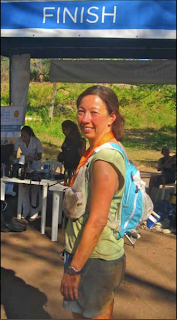 |
| Mud-strewn author. |
Back in Moyogalpa, we would join Don, who had run a courageous 25K on an injured hip, and later Brian, who would finish in darkness from 100 grueling kilometers up and down both volcanoes. At the post-race banquet, Jen received her award of a mask of a horse, crafted by the country’s top mask artisan.
We were all heartened to learn that local hero (and destined to be international star) Johnson Cruz, won the survivor race, beating Pak. Warm and humble, but one of the toughest men on the planet, Johnson also ran with the kids in the children’s race. He would return to his modest farm in Moyogalpa while we all jetted back to the states, having run for a while in that magic spot between fire and water.
Ometepe
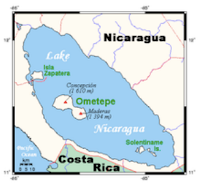 Two volcanoes form most of the island of Ometepe, which means “two hills” in the native Nahuatl language. It sits in the largest lake in Central America: Lake Nicaragua, an oval-shaped lake about 110 miles long. Its breathtaking beauty and biodiversity make Ometepe a great ecotourism destination.
Two volcanoes form most of the island of Ometepe, which means “two hills” in the native Nahuatl language. It sits in the largest lake in Central America: Lake Nicaragua, an oval-shaped lake about 110 miles long. Its breathtaking beauty and biodiversity make Ometepe a great ecotourism destination.The perfect cone of the largest of the volcanoes, Concepcion, is 5,577 feet high and is the site of the 25K and the longer races. The smaller is Maderas, at 4,573 feet, which the 50K racers had to climb.
Roughly 42,000 people live on the island, 15,000 of whom live in the race’s host town of Moyogalpa. For a flyover of the 50K course, see Rob’s video: www.youtube.com/watch?v=15-Y-qY4G6w
Related reports
Official website: http://fuegoyagua.org/
News reel of the survival run, featuring Junyong Pak, Olof Dallner, and Johnson Cruz: globalnews.ca/video/461172/survival-run-only-two-racers-arrive-alivein-thesurvival-run
Yassine Diboun’s blog of the 100K: trailandultrarunning.com/fuego-y-agua-2013
There are others, including interviews and videos, Just Google “Fuego y Agua”.
